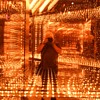Posted 11 years ago
 rniederman
rniederman
(346 items)
Let’s face it. Early wood and brass cameras are not exactly mainstream collectables and somewhat confusing. So as a public service (I know you all live for this), here are some basics about pre-1900 American field cameras to help understand what you might be seeing while on a ‘pick.’ Then again, I expect to be contacted if anything awesome is found!
Three basic field [portable] camera body patterns are shown (left to right): English Compact, Tailboard, and Front Focus. There are other exotic styles, but these are the base designs. The tailboard and front focus cameras are somewhat similar yet differ in the way a photographer focuses the image. The English Compact design is a style that collapses the camera into a very small form.
The English Compact body pattern is quite different than what is normally found. The design was originally created by English builders (hence the moniker) and infrequently copied by American makers. When the front standard is pushed all the way into the rear body (the lens and other accessories must first be removed), the base folds upward to create a pseudo case. The folded camera has the advantage of being quite thin and easily transported. Shown is a decked out c.1892 4x5 inch “Universal” by the Rochester Optical Company, NY. (This particular camera has non-standard accessories such as a rare Mathein shutter, viewfinder, and rollerblind shutter.)
A ‘tailboard’ design means that the rear portion of the camera with the ground glass (called ‘rear standard’) moves back and forth on a base, such as rails, for focusing. The rear can either be push-pull or rack and pinion geared. The front portion of the camera with lens board (‘front standard’) is secured to the base. This design started appearing in the late 1850s and by the 1880s was very popular. This style in 5 x 7 and 5 x 8 inch formats was often sold or upgraded for stereo work. Shown is a 1880s 5x8 inch format “Marvel” made by Franklin Putnam, NY.
The front focus body pattern is the opposite of the tailboard. The rear standard is immovable while the front moves back and forth to focus. As with the tailboard pattern, when the front and rear standards are pushed together, the camera’s base can be folded (hinged) upward to fit into a separate protective wooden case. Shown is a c.1887 4x5 inch “Peerless” with its original wooden case made by the Rochester Optical Company, NY.
As far as materials, the majority are polished mahogany bodies mounted on cherry wood rails. The English Compact designs are typically all mahogany. The quality of wood finish will vary by camera maker and model. Some American makers’ wood has fine furniture finish quality. Entry level cameras have lesser finishes, and so forth. What’s interesting is that, unlike American cameras, the majority of British cameras have exceptional construction, fit and finish.
The majority of American pre-1900 wood cameras have brass fittings, but some have highly polished nickel-plated brass hardware as seen with the Peerless field view camera.
In terms of collectability (aside from rare models, exotic designs, condition, completeness, etc.), the smallest cameras (3¼ x 4¼ and 4x5 inch formats) are the most desirable and good condition examples tend to have more value. The American 3¼ x 4¼ size appears rarely yet equivalent English models are often found. Mid format sizes such as 5x7 and 5x8 inch are more common but coveted because some collectors will make an effort to convert to more valuable stereo models. Some of the tailboard models were originally made as large as 25x30 inches ... huge by anyone’s standard and exceedingly rare.
The main challenge for collectors and pickers to understand is what is original to the camera, what has been replaced, etc. As with most any antique, this takes time to learn and one of the primary reasons antique dealers tend to avoid early wood and brass cameras.























Hello Rob!!! beautiful camera my friend:)!!!!
Thanks, nldionne!
Thanks, mustangtony!
Thanks for taking the time to write such an informative post, it's more info than I can take in. So I WILL contact you if I ever stumble upon something remotely like these fine specimens.
David
Thanks, David ... appreciate the 'love' and comment.
Thanks, vetraio50 and f64imager!
Great post, Rob. I enjoyed the info greatly. As with all serious collecting it takes experience,experience,experience. Maybe one day I will graduate to wood and brass. It's a relief to know that this era of cameras are being saved correctly for future generations. Super job and once again awsume cameras.
Thanks for the comment, Henry!
Thanks, blunderbuss2!
Thanks, shughs!
Thanks, Don!
Thanks, Sean!
Thanks, Phil!
Thanks, MattyG!
Thanks, aghcollect!
Thanks, officialfuel!
Thanks, flask!